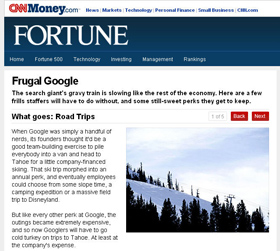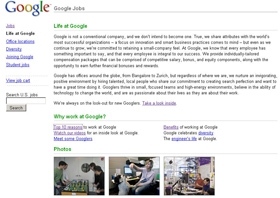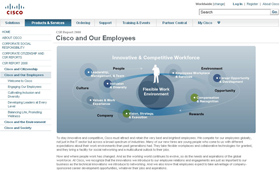Recap: Google has slipped from number one (two years running) to a mere number four on Fortune’s list of the ‘100 Best Companies to Work For.’ Why? Partly because companies one through three have gotten ahead of them. But also (according to Fortune) because Google has eliminated some ‘frills’–most notably, afternoon tea and the annual all-expenses-paid ski trip.
Since few companies on earth provide afternoon tea to supplement their all-day, all-free offerings of fabulous food—it may be hard to see why this change would be a blow to Google’s reputation. But as we know, perception trumps reality, and the important point is this: Once a company has become famous as an endless fountain of goodies, closing the spigot even a little can disrupt that image. (To see what actually got cut at Google, check out ‘Frugal Google.’)
The Fortune rankings are determined primarily by questionnaires sent to employees (sampling at least 400 per company), and there’s no detailed breakout of who-said-what about a particular company. So a bit of sleuthing was required to get a better picture of Google’s slight downhill slide. The big surprise (to me anyway): Although Google was number one on the overall list in 2007 and 2008, it didn’t even show up as one of the top companies on the ‘perks’ indexed in the Fortune rankings. The perks evaluated include basic benefits like health care, as well as extras such as child care, sabbaticals, telecommuting–and Google doesn’t rank high on any of them.
So number-one Google wasn’t actually lavishing its employees with exceptional benefits. Nope. The benefits were certainly good enough, but the real perk was ambiance—an idyllic work environment that made employees feel special, valued, and carefully cared for. To get a full picture of this widely publicized mystique, check out the in-depth exploration Fortune provided when Google topped the list in 2007.
Yet you won’t find a lot of hype over at the Google Careers site. Google did not (and doesn’t) depict its company as paradise, just as a really nice place to work. The ‘Top Ten Reasons to Work at Google‘ page stresses opportunities to create, participate, and achieve—and although it does mention free food, that’s number 10.
Which brings us to today’s first takeaways: (1) remember that the Careers site sets up expectations, but (2) don’t forget that visitors bring expectations with them. Most of last year’s 770,000 applicants for 350 jobs at Google (yes, really) probably came to the Careers site with a pre-formed opinion about what it would be like to work for the company. Do visitors to your site have a pre-formed opinion? If so, what is it?
And if visitors don’t have an idea already in mind, then the Careers site will create that all-important first impression …
The final takeaway: perks provide a significant opportunity to shape the employer brand. They demonstrate the value placed on employees by the company—and that’s the message to keep in mind. So if you showcase benefits, present them as truly integral to the company culture, not just competitive lures or business obligations. For a very interesting example, take a look at how Cisco (number five on the Fortune list) weaves its employer brand into a far-reaching corporate vision.
Lucy is Editor at Corporate Eye





